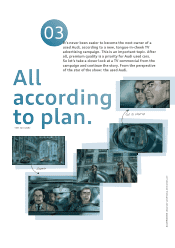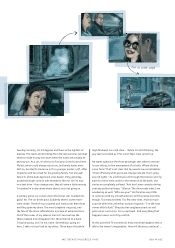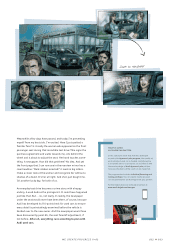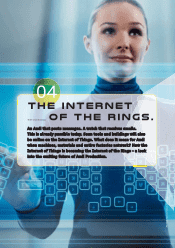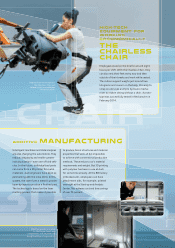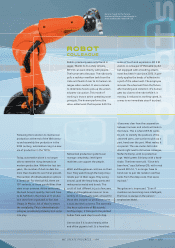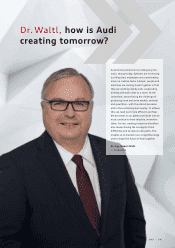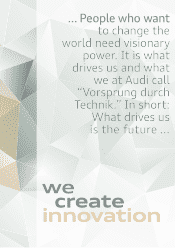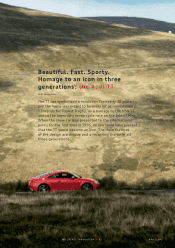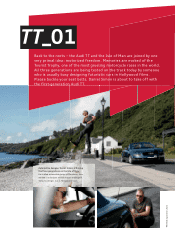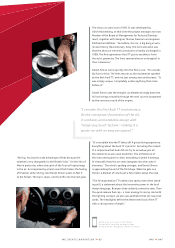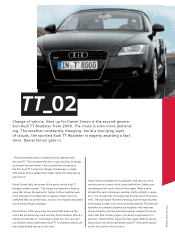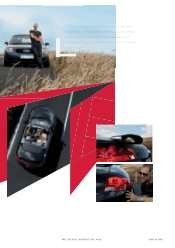Audi 2014 Annual Report Download - page 39
Download and view the complete annual report
Please find page 39 of the 2014 Audi annual report below. You can navigate through the pages in the report by either clicking on the pages listed below, or by using the keyword search tool below to find specific information within the annual report.
The point of Industry . is not a factory
devoid of people, but rather to provide
the employees optimal support as they
go about their work. In the future,
robots will do the jobs that people don’t
want to do because they are strenuous,
monotonous or unergonomic, such as
instal lation work in the vehicle interior
or overhead work. Employees would
then perform more challenging tasks.
Machine monitoring, programming,
and plant repair and maintenance are
already becoming increasingly signifi -
cant fi elds of activity at factories today.
Waltl and Neugebauer have come to
the end of their tour. Time for the fi rst
co ee of the morning. The production
workers in their gray and red work
clothes stream into the mini-mart. The
shop smells of fresh-baked rolls.
Neugebauer stares thoughtfully into his
steaming co ee. “I have one more ques-
tion,” he begins. “How do you manage
to develop so many innovations in prac-
tice ?” Waltl smiles. “Courage, that’s our
secret,” he says. “We rely on people with
courage. They think outside the box,
in particular they are forward- thinkers.
They are taking Audi Production step-
by-step toward Industry ..”
PHOTOS : AUDI AG, Uli Weber
Steam and water powered the fi rst
mechanical production plants. In the late
th century, they marked the fi rst in-
dustrial revolution – known from today’s
perspective as Industry .. The use
of electrical energy and the division of
labor in the slaughterhouses of Cincin-
nati rang in the second revolution. Hen-
ry Ford perfected this way of working
with assembly line manufacturing. In the
s, electronics and IT led to further
automation and Industry .. Compo-
nents that provide a constant fl ow of
data and networked machines – that is
Industry ..
INDUSTRY 4.0
The Fraunhofer-
Gesellschaft and
Audi have been
collaborating for eight
years. How are you
together advancing
Industry . ?
NEUGEBAUER :
NEUGEBAUER :
We are
building bridges between
science and industry,
for example with our E research factory. It models
production under realistic conditions. We are using
it to research techno logies for the future.
WA LT L : But our work in the area of Industry .
is not limited to just technologies. We are also
conducting joint research into the integration and
role of people in the production of the future.
This includes, for example, increasing the fl exibility
of work and the cooperation between man and
machine.
Augmented reality, intelligent tools – all of that
is already reality at Audi. Are we really on
the threshold of a fourth industrial revolution ?
Or are we already in the middle of Industry . ?
WA LT L : Audi did not wait around until the term
Industry . was born in . Even in Production,
we are already working on tomorrow. That is
where we get our advantage. We therefore speak
of an evolution.
NEU GEBAUER :
NEU GEBAUER :
Every revolution is preceded by
an evolution. But the e ects of networking, the
gigantic amounts of data and their analysis are
still to come. We currently fi nd ourselves in an
evolutionary process that will make the fourth
industrial revolution possible in the future. It’s
not behind us ; it’s still to come.
What challenges have to be met on the road to
Industry . ?
WA LTL :
I see two things here. One is training and
advancement. We need to consider today how
we prepare our employees for tomorrow. Expertise
in the areas of mechatronics, electronics and IT is
becoming increasingly important. Second, we have
to consider the interfaces when investing in tech-
nologies. A machine has to be able to hook into the
shared network later. This is the only way we can
take advantage of the opportunities presented by
data collection and analysis.
NEU GEBAUER :
NEU GEBAUER :
For this we need standards, not
just within the company, but worldwide. Further
expansion of broadband is also needed. Today
we have average response times in the network of
milliseconds on average. . milliseconds are
required for real-time data transfer. Another chal-
lenge is the security of these tremendous amounts
of data. We have a vision of Industry . today,
but we still have a lot of homework to do until it
can be implemented.


